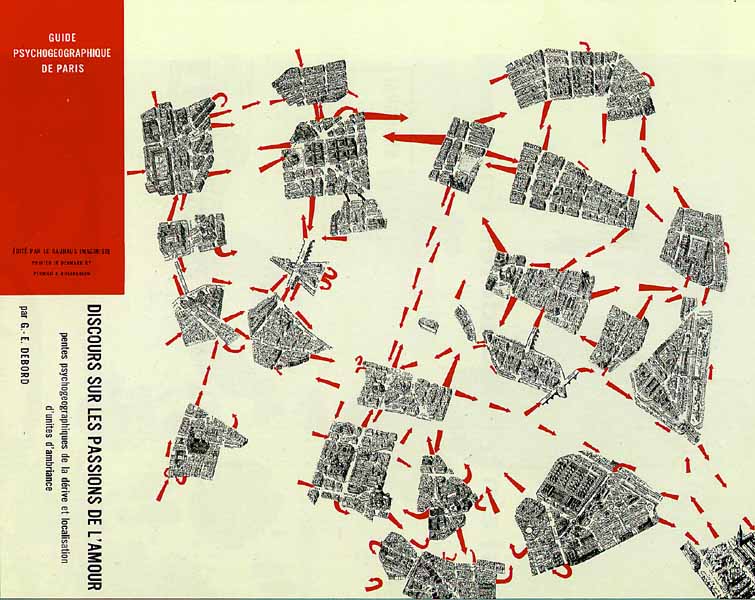Is it worth buying a guide book to a city that no longer exists? There are guides to places that never existed. Invisible Cities by Calvino provides a kind of general purpose guide to our curiosity about life in exotic places. Tolkien and every goblin-merchant that followed him always provided a map at the beginning of the book. But what if the guide book is merely out of date?
Notting Hill Editions recently sent me a review copy of Nairn’s Paris, an expertly timed encore to Penguin’s reissue of Nairn’s London. But unlike Penguin, this is no paperback facsimile. This is a stylish stitched hardback that has been newly typeset and given an introduction by current Paris resident Andrew Hussey. But was it worth the bother, now that some of the more transient sights have disappeared, and new buildings will be omitted? And the book is especially vulnerable to transience (Baudelaire would approve) as Nairn opens with his customary disclaimer “This book is simply a record of what I enjoyed in Paris.” The answer is yes.
I always find it interesting to read an earlier written account of a place I am visiting, if enough of the built environment remains. I’m not overly fond of standing in empty fields where medieval battles once took place, although it is good timing. I’m not a born psychogeographer. Yet Guy Debord’s Paris is the birthplace of such geography, and it was roughly the same Paris that Nairn was visiting, which surely makes this confluence of two kinds of fashionable plodding, Subtopia and Psychogeography, of some kind of academic interest.

Just look at that imprint date! 1968! If Nairn had visited a year later he could have added a chapter on Manifestations. So not only is this a lyrical and practical guide to one of the great cities, it is the description of the scenery behind a significant period in its history. Speaking of Baudelaire, Nairn becomes rather the flâneur in Paris, more so than in his films. He looks at you looking at him looking at the city. But I’m not going to write this PhD for you. The point is that Nairn is such a wonderful observer that the book is a pleasure to just sit and read.
Rive Gauche is everyone’s dream of Paris. And it is still true, one of Europe’s least likely miracles. For how much longer I don’t know; but at the moment the boulevard Saint-Germain is still a place in which it is honourable and decent to be either intellectual or unintellectual.
His usual pessimism about likely preservation. My favourite part is his account of Pont Bir-Hakeim (p. 122), comparing it to his lodestar Newcastle, where road traffic passes below the Metro. It’s a location I found startling when I happened across it and felt the same sense of accidental industrial theatre. “The pedestrian is king all the time”, take note Urbanists he is saying, “This pattern, which could so easily be brutal, has been transformed into an outdoor room.” He then walks into a Hitchcockian cross-fade; a synoptic fairground scene with waxwork fortune tellers whose worn out cogs leave them out of sync. Surely a metaphor for something.
Nairn’s overall thesis is that it is the assemblage of buildings itself animated by the signs and people that makes it a magical place. The monuments themselves are underwhelming, as any etching or plan of them will emphasise.
Paris is a collective masterpiece, perhaps the greatest in the world.
The introduction is very good, at introducing both Nairn and his book and grounding it in 2017. I applaud the fact Andrew Hussey doesn’t leer over Nairn’s alcoholism, which with Nairn is the biographical equivalent of eating a doughnut without licking your lips. The only thing I didn’t like about the introduction was that he said all that stuff about Debord, 1968 and Psychogeography, which I had though of all by myself when reading the book (I always read introductions afterwards) and I’d thought I was being unusually clever.
The physical object demands comment because it is so considered. It’s pocket sized, has a ribbon, therefore perfect for its intended use. The book block is wonderful. Black type with red details, such as numerals. The paper is light, thin but durable. An excellent book-white colour similar to Munken Pure. Charles Boyle’s typesetting is dignified and elegant, the margins increasing by about 20% from centre, up and outwards like a Kelmscott Press book. This means you have room for your thumbs at the side and bottom, and the text creates two windows between three neat columns of negative space. But it only works so well because the book is stitched. Perfect binding would require a lot more space in the middle because they don’t lay flat. The cover is good but less successful. The green cloth is contemporary and will age well, similar to Windsor from Ratchford. The endpapers are the same shade of green and tough, like Fedrigoni Sirio. Excellent for the pocket. But the foiling is less successful. The quote on the cover seems too large, or long, to me. Wide coverage with drop-outs in some areas, light serif letterforms nearby; it’s asking a lot of foil going onto book cloth. Foilco have a product that will do it, but what they used has acted like a Kurz foil and the press either ran slightly too hot or too slow and there’s light flashing around the glyphs. The back text has a more shallow impression so as to not fill in the type, but it sits on top of the weave and lacks definition. But I’d have done the same when faced with these extremes. These things are best resolved at the design stage, and designing for cloth is difficult. There are no shortcomings that obscure the fact this is an excellent book bound beautifully.
Nairn’s Paris
Notting Hill Editions
ISBN 9781910749494
£14.99
Available from 19th April 2017